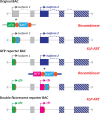Bacterial artificial chromosomes as recombinant reporter constructs to investigate gene expression and regulation in echinoderms
- PMID: 29045542
- PMCID: PMC6158795
- DOI: 10.1093/bfgp/elx031
Bacterial artificial chromosomes as recombinant reporter constructs to investigate gene expression and regulation in echinoderms
Abstract
Genome sequences contain all the necessary information-both coding and regulatory sequences-to construct an organism. The developmental process translates this genomic information into a three-dimensional form. One interpretation of this translation process can be described using gene regulatory network (GRN) models, which are maps of interactions among regulatory gene products in time and space. As high throughput investigations reveal increasing complexity within these GRNs, it becomes apparent that efficient methods are required to test the necessity and sufficiency of regulatory interactions. One of the most complete GRNs for early development has been described in the purple sea urchin, Strongylocentrotus purpuratus. This work has been facilitated by two resources: a well-annotated genome sequence and transgenes generated in bacterial artificial chromosome (BAC) constructs. BAC libraries played a central role in assembling the S. purpuratus genome sequence and continue to serve as platforms for generating reporter constructs for use in expression and regulatory analyses. Optically transparent echinoderm larvae are highly amenable to transgenic approaches and are therefore particularly well suited for experiments that rely on BAC-based reporter transgenes. Here, we discuss the experimental utility of BAC constructs in the context of understanding developmental processes in echinoderm embryos and larvae.
Figures



Similar articles
-
Developmental effector gene regulation: Multiplexed strategies for functional analysis.Dev Biol. 2019 Jan 1;445(1):68-79. doi: 10.1016/j.ydbio.2018.10.018. Epub 2018 Oct 28. Dev Biol. 2019. PMID: 30392838 Free PMC article.
-
Employing BAC-reporter constructs in the sea anemone Nematostella vectensis.Integr Comp Biol. 2013 Nov;53(5):832-46. doi: 10.1093/icb/ict091. Epub 2013 Aug 16. Integr Comp Biol. 2013. PMID: 23956207
-
Techniques for analyzing gene expression using BAC-based reporter constructs.Methods Cell Biol. 2019;151:197-218. doi: 10.1016/bs.mcb.2019.01.004. Epub 2019 Feb 23. Methods Cell Biol. 2019. PMID: 30948008 Free PMC article. Review.
-
Architecture and evolution of the cis-regulatory system of the echinoderm kirrelL gene.Elife. 2022 Feb 25;11:e72834. doi: 10.7554/eLife.72834. Elife. 2022. PMID: 35212624 Free PMC article.
-
Omics approaches to study gene regulatory networks for development in echinoderms.Brief Funct Genomics. 2017 Sep 1;16(5):299-308. doi: 10.1093/bfgp/elx012. Brief Funct Genomics. 2017. PMID: 28957458 Review.
Cited by
-
The Use of Larval Sea Stars and Sea Urchins in the Discovery of Shared Mechanisms of Metazoan Whole-Body Regeneration.Genes (Basel). 2021 Jul 13;12(7):1063. doi: 10.3390/genes12071063. Genes (Basel). 2021. PMID: 34356079 Free PMC article. Review.
-
Developmental effector gene regulation: Multiplexed strategies for functional analysis.Dev Biol. 2019 Jan 1;445(1):68-79. doi: 10.1016/j.ydbio.2018.10.018. Epub 2018 Oct 28. Dev Biol. 2019. PMID: 30392838 Free PMC article.
-
Local Genomic Instability of the SpTransformer Gene Family in the Purple Sea Urchin Inferred from BAC Insert Deletions.Genes (Basel). 2024 Feb 9;15(2):222. doi: 10.3390/genes15020222. Genes (Basel). 2024. PMID: 38397211 Free PMC article.
-
Generating endogenous Myh11-driven Cre mice for sex-independent gene deletion in smooth muscle cells.JCI Insight. 2023 Jul 24;8(14):e171661. doi: 10.1172/jci.insight.171661. JCI Insight. 2023. PMID: 37289544 Free PMC article.
-
Beyond Adult Stem Cells: Dedifferentiation as a Unifying Mechanism Underlying Regeneration in Invertebrate Deuterostomes.Front Cell Dev Biol. 2020 Oct 20;8:587320. doi: 10.3389/fcell.2020.587320. eCollection 2020. Front Cell Dev Biol. 2020. PMID: 33195242 Free PMC article. Review.
References
-
- Hertwig O. Beiträge zur Kenntniss der Bildung, Befruchtung und Theilung des thierischen Eies. Morphol Jahrb 1876;1:347–434.
-
- Hultin T. The effect of puromycin on protein metabolism and cell division in fertilized sea urchin eggs. Experientia 1961;17:410–1. - PubMed
-
- Evans T, Rosenthal ET, Youngblom J, et al.Cyclin: a protein specified by maternal mRNA in sea urchin eggs that is destroyed at each cleavage division. Cell 1983;33:389–96. - PubMed
-
- Metchnikoff E. Lectures on the comparative pathology of inflammation: delivered at the Pasteur Institute in 1891. London: Kegan Paul, 1893.
Publication types
MeSH terms
Grants and funding
LinkOut - more resources
Full Text Sources
Other Literature Sources
Research Materials
Miscellaneous

